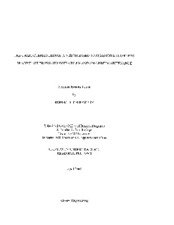| dc.creator | Effinger, Robert T | |
| dc.date.accessioned | 2013-02-22T20:39:31Z | |
| dc.date.available | 2013-02-22T20:39:31Z | |
| dc.date.created | 2003 | |
| dc.date.issued | 2013-02-22 | |
| dc.identifier.uri | https://hdl.handle.net/1969.1/ETD-TAMU-2003-Fellows-Thesis-E55 | |
| dc.description | Due to the character of the original source materials and the nature of batch digitization, quality control issues may be present in this document. Please report any quality issues you encounter to digital@library.tamu.edu, referencing the URI of the item. | en |
| dc.description | Includes bibliographical references (leaf 16). | en |
| dc.description.abstract | To transport humans into space routinely and safely a spacecraft must be capable of proximity operations (maneuvers close to other spacecraft), and on-orbit maintenance. These operations require an intelligent system that identifies and informs neighboring spacecraft of their relative positions and orientations. VISNAV[[¹][²][³]] is a VISion-based sensing and NAVigation system that is able to determine the position and orientation of objects in 3-D space. The non-contact nature and quick update rate of this system make it an attractive option for spacecraft autonomous on-orbit maintenance, proximity operations, rendezvous and docking, and many other motion-tracking applications. The VISNAV system has been explored as an option for autonomous spacecraft rendezvous and docking applications. In these tests the VISNAV system loses some accuracy as the beacons move away from the bore sight of the sensor. Also, the system can become singular for certain vehicle and target light configurations. If the VISNAV system is to be used on real spacecraft it must be robust and failsafe, which means the model cannot become singular. The focus of this student project is to characterize the system accuracy as a function of distance and angle from bore sight of the sensor. The use of two sensors to create a "stereo" version of the VISNAV system will also be explored to increase the reliability and operating range of the system. | en |
| dc.format.medium | electronic | en |
| dc.format.mimetype | application/pdf | |
| dc.language.iso | en_US | |
| dc.publisher | Texas A&M University | |
| dc.rights | This thesis was part of a retrospective digitization project authorized by the Texas A&M University Libraries in 2008. Copyright remains vested with the author(s). It is the user's responsibility to secure permission from the copyright holder(s) for re-use of the work beyond the provision of Fair Use. | en |
| dc.subject | mechanical engineering. | en |
| dc.subject | Major mechanical engineering. | en |
| dc.title | The characterization of a vision-based navigation system for spacecraft proximity operations and on-orbit maintenance | en |
| thesis.degree.department | mechanical engineering | en |
| thesis.degree.discipline | mechanical engineering | en |
| thesis.degree.name | Fellows Thesis | en |
| thesis.degree.level | Undergraduate | en |
| dc.type.genre | thesis | en |
| dc.type.material | text | en |
| dc.format.digitalOrigin | reformatted digital | en |


